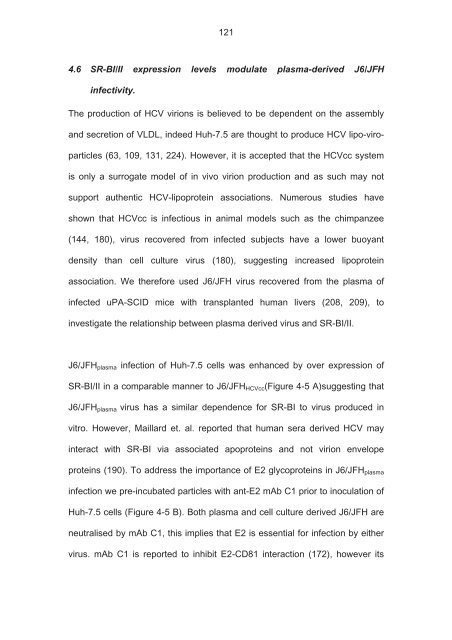The role of scavenger receptor BI in hepatitis - eTheses Repository ...
The role of scavenger receptor BI in hepatitis - eTheses Repository ...
The role of scavenger receptor BI in hepatitis - eTheses Repository ...
You also want an ePaper? Increase the reach of your titles
YUMPU automatically turns print PDFs into web optimized ePapers that Google loves.
121<br />
4.6 SR-<strong>BI</strong>/II expression levels modulate plasma-derived J6/JFH<br />
<strong>in</strong>fectivity.<br />
<strong>The</strong> production <strong>of</strong> HCV virions is believed to be dependent on the assembly<br />
and secretion <strong>of</strong> VLDL, <strong>in</strong>deed Huh-7.5 are thought to produce HCV lipo-viro-<br />
particles (63, 109, 131, 224). However, it is accepted that the HCVcc system<br />
is only a surrogate model <strong>of</strong> <strong>in</strong> vivo virion production and as such may not<br />
support authentic HCV-lipoprote<strong>in</strong> associations. Numerous studies have<br />
shown that HCVcc is <strong>in</strong>fectious <strong>in</strong> animal models such as the chimpanzee<br />
(144, 180), virus recovered from <strong>in</strong>fected subjects have a lower buoyant<br />
density than cell culture virus (180), suggest<strong>in</strong>g <strong>in</strong>creased lipoprote<strong>in</strong><br />
association. We therefore used J6/JFH virus recovered from the plasma <strong>of</strong><br />
<strong>in</strong>fected uPA-SCID mice with transplanted human livers (208, 209), to<br />
<strong>in</strong>vestigate the relationship between plasma derived virus and SR-<strong>BI</strong>/II.<br />
J6/JFHplasma <strong>in</strong>fection <strong>of</strong> Huh-7.5 cells was enhanced by over expression <strong>of</strong><br />
SR-<strong>BI</strong>/II <strong>in</strong> a comparable manner to J6/JFHHCVcc(Figure 4-5 A)suggest<strong>in</strong>g that<br />
J6/JFHplasma virus has a similar dependence for SR-<strong>BI</strong> to virus produced <strong>in</strong><br />
vitro. However, Maillard et. al. reported that human sera derived HCV may<br />
<strong>in</strong>teract with SR-<strong>BI</strong> via associated apoprote<strong>in</strong>s and not virion envelope<br />
prote<strong>in</strong>s (190). To address the importance <strong>of</strong> E2 glycoprote<strong>in</strong>s <strong>in</strong> J6/JFHplasma<br />
<strong>in</strong>fection we pre-<strong>in</strong>cubated particles with ant-E2 mAb C1 prior to <strong>in</strong>oculation <strong>of</strong><br />
Huh-7.5 cells (Figure 4-5 B). Both plasma and cell culture derived J6/JFH are<br />
neutralised by mAb C1, this implies that E2 is essential for <strong>in</strong>fection by either<br />
virus. mAb C1 is reported to <strong>in</strong>hibit E2-CD81 <strong>in</strong>teraction (172), however its

















